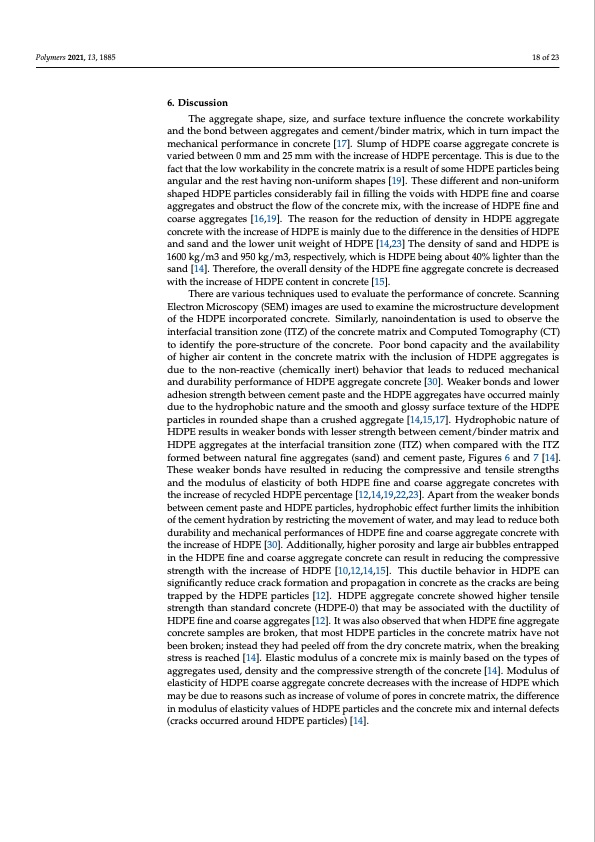
PDF Publication Title:
Text from PDF Page: 018
Polymers 2021, 13, 1885 18 of 23 6. Discussion The aggregate shape, size, and surface texture influence the concrete workability and the bond between aggregates and cement/binder matrix, which in turn impact the mechanical performance in concrete [17]. Slump of HDPE coarse aggregate concrete is varied between 0 mm and 25 mm with the increase of HDPE percentage. This is due to the fact that the low workability in the concrete matrix is a result of some HDPE particles being angular and the rest having non-uniform shapes [19]. These different and non-uniform shaped HDPE particles considerably fail in filling the voids with HDPE fine and coarse aggregates and obstruct the flow of the concrete mix, with the increase of HDPE fine and coarse aggregates [16,19]. The reason for the reduction of density in HDPE aggregate concrete with the increase of HDPE is mainly due to the difference in the densities of HDPE and sand and the lower unit weight of HDPE [14,23] The density of sand and HDPE is 1600 kg/m3 and 950 kg/m3, respectively, which is HDPE being about 40% lighter than the sand [14]. Therefore, the overall density of the HDPE fine aggregate concrete is decreased with the increase of HDPE content in concrete [15]. There are various techniques used to evaluate the performance of concrete. Scanning Electron Microscopy (SEM) images are used to examine the microstructure development of the HDPE incorporated concrete. Similarly, nanoindentation is used to observe the interfacial transition zone (ITZ) of the concrete matrix and Computed Tomography (CT) to identify the pore-structure of the concrete. Poor bond capacity and the availability of higher air content in the concrete matrix with the inclusion of HDPE aggregates is due to the non-reactive (chemically inert) behavior that leads to reduced mechanical and durability performance of HDPE aggregate concrete [30]. Weaker bonds and lower adhesion strength between cement paste and the HDPE aggregates have occurred mainly due to the hydrophobic nature and the smooth and glossy surface texture of the HDPE particles in rounded shape than a crushed aggregate [14,15,17]. Hydrophobic nature of HDPE results in weaker bonds with lesser strength between cement/binder matrix and HDPE aggregates at the interfacial transition zone (ITZ) when compared with the ITZ formed between natural fine aggregates (sand) and cement paste, Figures 6 and 7 [14]. These weaker bonds have resulted in reducing the compressive and tensile strengths and the modulus of elasticity of both HDPE fine and coarse aggregate concretes with the increase of recycled HDPE percentage [12,14,19,22,23]. Apart from the weaker bonds between cement paste and HDPE particles, hydrophobic effect further limits the inhibition of the cement hydration by restricting the movement of water, and may lead to reduce both durability and mechanical performances of HDPE fine and coarse aggregate concrete with the increase of HDPE [30]. Additionally, higher porosity and large air bubbles entrapped in the HDPE fine and coarse aggregate concrete can result in reducing the compressive strength with the increase of HDPE [10,12,14,15]. This ductile behavior in HDPE can significantly reduce crack formation and propagation in concrete as the cracks are being trapped by the HDPE particles [12]. HDPE aggregate concrete showed higher tensile strength than standard concrete (HDPE-0) that may be associated with the ductility of HDPE fine and coarse aggregates [12]. It was also observed that when HDPE fine aggregate concrete samples are broken, that most HDPE particles in the concrete matrix have not been broken; instead they had peeled off from the dry concrete matrix, when the breaking stress is reached [14]. Elastic modulus of a concrete mix is mainly based on the types of aggregates used, density and the compressive strength of the concrete [14]. Modulus of elasticity of HDPE coarse aggregate concrete decreases with the increase of HDPE which may be due to reasons such as increase of volume of pores in concrete matrix, the difference in modulus of elasticity values of HDPE particles and the concrete mix and internal defects (cracks occurred around HDPE particles) [14].PDF Image | Engineering Performance of Concrete Incorporated with Recycled HDPE

PDF Search Title:
Engineering Performance of Concrete Incorporated with Recycled HDPEOriginal File Name Searched:
6b2d9750f7cf13ccb459f476e519aec39ce1.pdfDIY PDF Search: Google It | Yahoo | Bing
Development of a solar powered Electric Ship The Electricship website originally started off as a project to develop a comprehensive renewable, affordable, modular electric ship... More Info
Modular Boat Hull Composite The case for a unsinkable, modular composite hybrid boat hull... More Info
MS Burgenstock Hybrid Electric Catamaran Lake Lucerne Unique shuttle servicing Lucerne to the Burgenstock Resort... More Info
Ground Power Unit GPU Powered by Lithium Ion Batteries The goal of the Ground Power Unit is to provide a readily accessible, modular, ready-to-power solution for remote power... More Info
| CONTACT TEL: 608-238-6001 Email: greg@electricship.com | RSS | AMP |